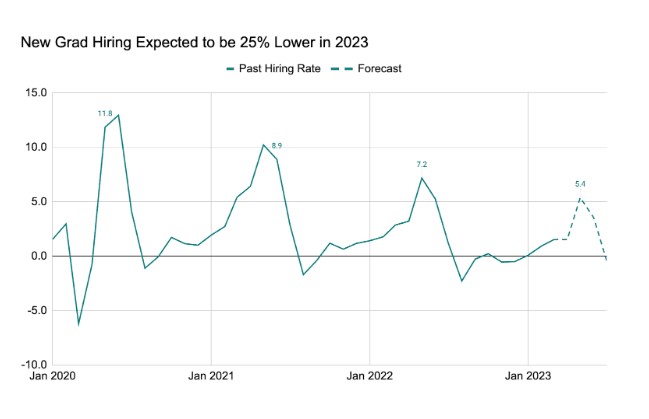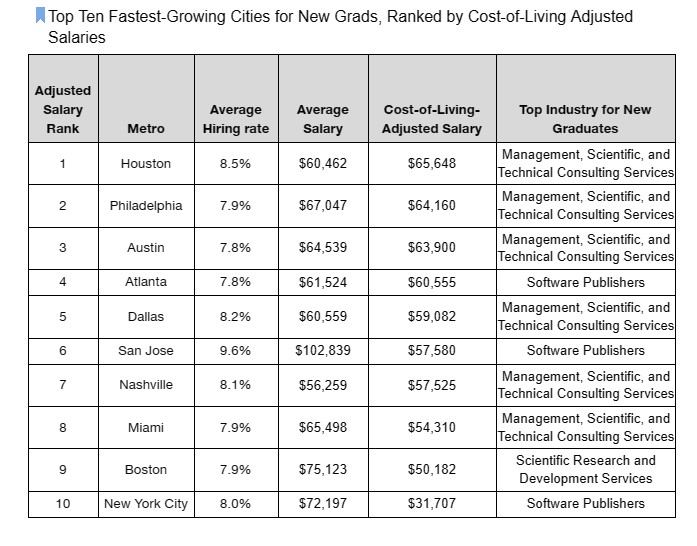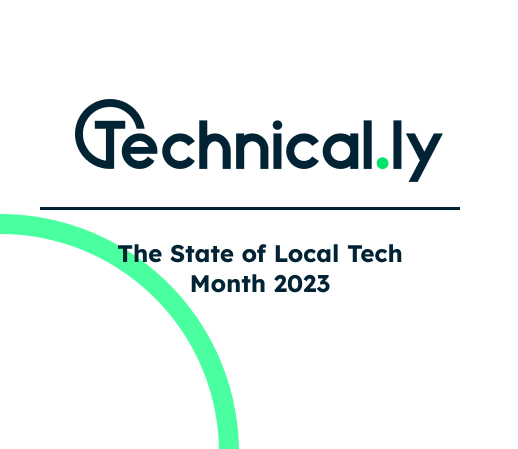The good news? A new report by Gusto forecasts there will still be plenty of tech jobs for this year’s college graduates, with job growth projected to be 5.4% in May 2023, compared to the annual baseline.
But especially amid a wave of tech layoffs and major workplace culture shifts, those jobs might not necessarily be in the industries they expect.

(Image via Gusto 2023)
An industry shift for tech jobs
Gusto economist Luke Pardue examined real-time data from the more than 300,000 small and midsize business clients on the Gusto HR management platform, and pinpointed the industries where the most job growth is happening.
“One surprising aspect of the report is the growth opportunities for new graduates in industries they may not have typically looked to for jobs right after school,” Pardue told Technical.ly. “While hiring overall is expected to fall by 25% compared to last year, industries like food and beverage and retail are expected to increase their hiring of new graduates in 2023 amid continued economic strength in those sectors.”
“Students graduating with tech-specific skills are able to look to new industries for opportunities this year.”Luke Pardue Gusto
That’s not to say that graduates with tech-related degrees will be serving coffee or running cash registers. The food and beverage and retail industries are increasingly hiring tech positions, including ecommerce managers and software engineers.
And the growth in food and beverage and retail subsectors is significant: They are expected to increase employment of new graduates in full-time positions by 9.6% and 7.7%, respectively.
“With the ongoing technological disruptions in those sectors, companies are looking for employees with the skills new graduates are leaving school with,” Pardue said. “Students graduating with tech-specific skills are able to look to new industries for opportunities this year.”
Other job growth areas include education, accounting, healthcare and accommodations.
Where is the job growth?
New college grads are still in high demand in cities across the US, most notably in Texas, where urban hubs like Houston and Austin continue to grow.
Hubs like New York City and San Jose are still growing, too, but, when you adjust salaries for cost of living, smaller hubs are looking increasingly attractive.
The five fastest growing cities for new grads after a cost of living adjustment are Houston, Philadelphia, Austin, Atlanta and Dallas.
And the top industries for new graduates across the top 10 fastest-growing cities for this group: management, scientific and technical consulting services, following by software publishers, then scientific R&D services.

(Image via Gusto 2023)
Houston’s average starting salary of $60,000 isn’t the highest by far, but the Texas city’s cost of living is 8% lower than the national average, putting it on top with an adjusted starting salary of $65,000.
Philadelphia, a squarely mid-Atlantic city whose metropolitan area includes southern New Jersey and northern Delaware, stands out near the top of the list as a “northern” city among affordable cities in the south and the south-central regions.
Across the largest 50 metro areas, New York City and Philadelphia have the fifth and sixth highest rates of employment growth for new graduates.
“The mid-Atlantic region is shaping up quite strong this graduation season,” Pardue said. “Looking across the largest 50 metro areas, New York City and Philadelphia have the fifth and sixth highest rates of employment growth for new graduates, respectively. The mid-Atlantic’s density of high-quality colleges and universities creates a strong talent pool of skilled young graduates that companies in the region are able to pull from.”
The next five cities to round up the top 10 fastest-growing cities for new grads after a cost of living adjustment are San Jose, Nashville, Miami, Boston and New York City.
San Jose in California’s Silicon Valley, the city with the highest hiring rate for new grads before adjusting for cost of living, is one of the most expensive cities the US, and it is also the only city on the list where new grads can expect to earn six figures right off the bat. Boston and New York, similarly, offer higher-than-average starting salaries, but have very high costs of living.
San Jose’s $102,000 average starting salary drops to $57,000 when adjusted for cost of living. New York City’s starting average salary of $72,000 feels like just $32,000 when cost of living is taken into account, while Boston’s starting average of $75,000 feels like $50,000. By contrast, Philly’s lower average starting salary of $67,000 feels like $64,000.

This editorial article is a part of State of Local Tech Month of Technical.ly’s editorial calendar.
Before you go...
Please consider supporting Technical.ly to keep our independent journalism strong. Unlike most business-focused media outlets, we don’t have a paywall. Instead, we count on your personal and organizational support.
3 ways to support our work:- Contribute to the Journalism Fund. Charitable giving ensures our information remains free and accessible for residents to discover workforce programs and entrepreneurship pathways. This includes philanthropic grants and individual tax-deductible donations from readers like you.
- Use our Preferred Partners. Our directory of vetted providers offers high-quality recommendations for services our readers need, and each referral supports our journalism.
- Use our services. If you need entrepreneurs and tech leaders to buy your services, are seeking technologists to hire or want more professionals to know about your ecosystem, Technical.ly has the biggest and most engaged audience in the mid-Atlantic. We help companies tell their stories and answer big questions to meet and serve our community.
Join our growing Slack community
Join 5,000 tech professionals and entrepreneurs in our community Slack today!

The person charged in the UnitedHealthcare CEO shooting had a ton of tech connections

Delaware students take a field trip to China using their tablets and ChatGPT

Northern Virginia defense contractor acquires aerospace startup in $4B deal




